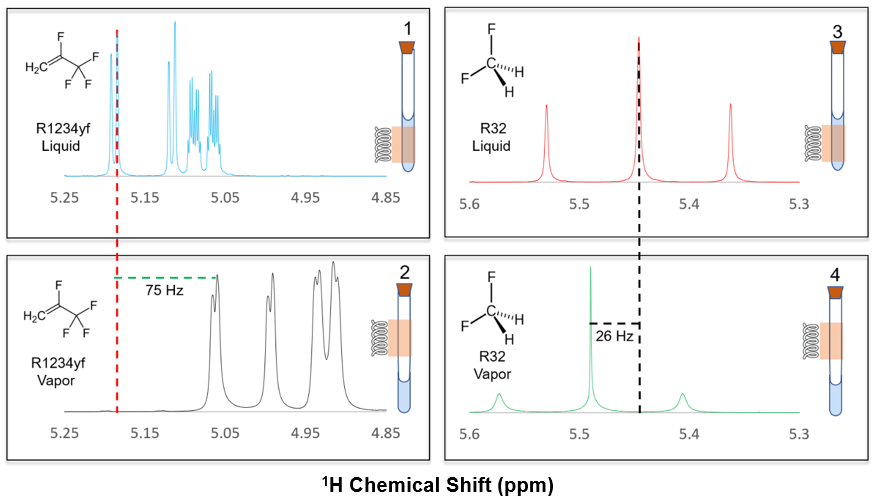Summary
NMR spectroscopy is routinely used to analyze chemical mixtures in the liquid phase. It is far less common for these techniques to be applied to vapor-phase mixtures. We have developed quantitative NMR techniques to make high accuracy, low uncertainty measurements for mixtures in the vapor phase. With these methods, we can measure a variety or thermophysical properties such as vapor-liquid equilibrium, partitioning, and adsorption, which are critical parameters in many industries. Current applications include refrigerants, forensic science, and air quality.
Description

In-situ vapor-liquid equilibrium (VLE). We are applying vapor-phase NMR to measure VLE in-situ. We are currently applying this methodology to industrially important systems such as refrigerants and natural gas. The most widely used refrigerants have high global warming potential. Drop-in replacements with more sustainable properties could be designed from accurate VLE measurements on binary mixtures. We are also making measurements of VLE for natural gas and water mixtures, which are important for the development of accurate models that are used in the operation of distribution pipelines.
Competitive vapor adsorption. Carbon adsorbents are commonly used to extract ignitable liquid residue from fire debris (arson investigations) and to monitor workplace exposure to organic chemicals. Using quantitative vapor phase NMR, we can monitor the adsorption of multiple species to a solid adsorbent, in-situ, simultaneously, and as a function of time. Currently, we are using these methods to investigate competitive adsorption phenomena in activated carbon as it relates to fire debris analysis and workplace safety. These measurements provide a better fundamental understanding of the underlying science of adsorption onto activated carbon.
Vapor-solid equilibrium (VSE) of compounds relevant to cannabis. Cannabis is a natural product and a complex matrix of many chemical components. There is currently a push towards the development of a reliable cannabis breathalyzer that can determine recent cannabis use. We are using NMR spectroscopy to understand the partitioning behavior between various cannabis components in the vapor-phase and solid-phase adsorbents which could be used to capture these components for analysis.
Selected publications:
Suiter, C. L., McLinden, M. O., Bruno, T.J., and Widegren, J.W., 2019. Composition Determination of Low-Pressure Gas-Phase Mixtures by 1H NMR Spectroscopy. Analytical Chemistry 91, 7, 4429-4435. https://doi.org/10.1021/acs.analchem.8b04955.
Suiter, C. L., Malave, V. D., Garboczi, E. J., Widegen, J. W., McLinden, M. O. Nuclear Magnetic Resonance Spectroscopy for the In Situ Measurement of Vapor-Liquid Equilibria. Journal of Chemical & Engineering Data, in press. https://dx.doi.org/10.1021/acs.jced.0c00113

